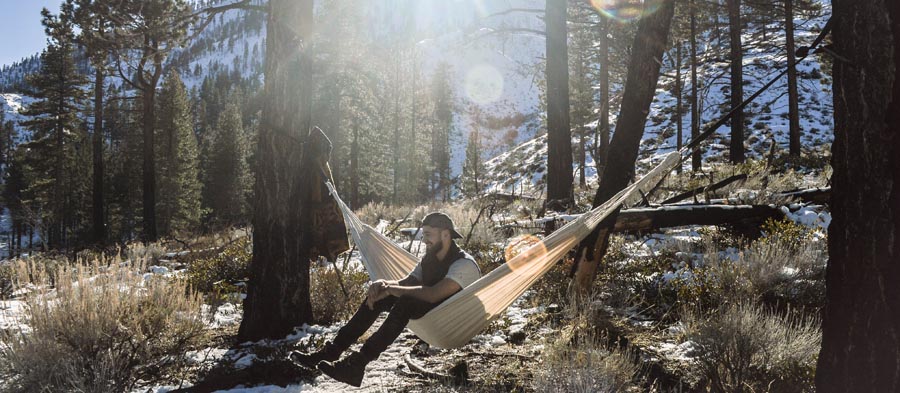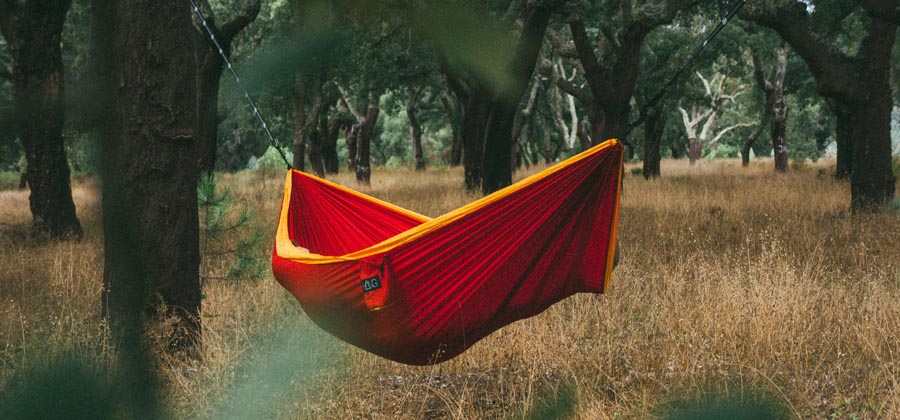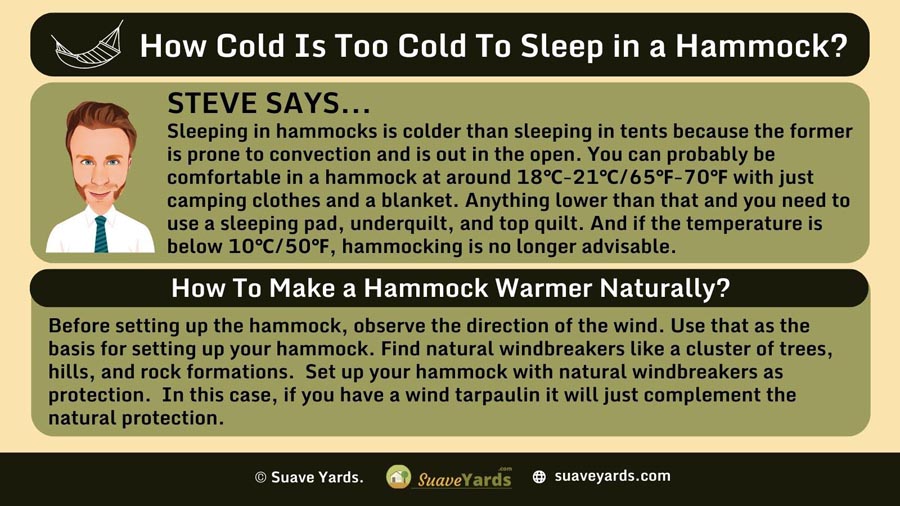
No weather is too hot or too cold for adventurers. They could go camping or backpacking in any weather.
But how cold is too cold for a hammock?
As camping enthusiasts know, sleeping in hammocks tends to be colder than tents.
It’s logical too: Hammocks are colder because they are open while tents provide better coverage.
But how cold is too cold to hammock?
Let’s talk about the cold truth.
Sleeping in hammocks is colder than sleeping in tents because the former is prone to convection and is out in the open. You can probably be comfortable in a hammock at around 18℃-21℃/65℉-70℉ with just camping clothes and a blanket. Anything lower than that and you need to use a sleeping pad, underquilt, and top quilt. And if the temperature is below 10℃/50℉, hammocking is no longer advisable.
Are Hammocks Cold to Sleep In?
Hammocks are great for the summer but are generally cold to sleep in when the temperature is low.
There are a couple of reasons why this is so…
First, is convection, which refers to heat loss through moving air. Since the hammock is hanging, you can expect your back and butt to feel the cold air.
Second, hammocks are out in the open, which means less coverage.
What Temperature Can You Sleep in a Hammock?

The right answer is based on your cold tolerance.
According to research, the lack of muscle protein called alpha-actinin-3 causes a person to be more tolerant of the cold. The protein is present in the skeletal muscle gene known as ACTN3.
However, one in five people has alpha-actinin-3 deficiency, and they are said to be more resilient to the cold.
Still, many would prefer to have a number in mind.
So, here goes.
Temperature: 18℃-21℃/65℉-70℉
At night, such temperature is already quite chilly.
But most people can probably sleep in a hammock with just a blanket.
Temperature: 15.5℃/60℉
At this temperature, campers must sleep in a sleeping bag in a hammock.
The sleeping bag is effective in breaking up convection as it traps a layer of air between you and nature.
For some to be comfortable, a sleeping pad must be added.
At this temperature, there is a tendency that the wind will be quite rough. You would need a wind tarp for that.
Temperature: 10℃/50℉
This is too cold.
Without the right gear, you might feel as if you are stranded in Antarctica.
You will need an underquilt as insulation.
You will most likely need a top quilt too.
Consider buying four-season quilts for the adventure.
How to Stay Warm in a Hammock in the Cold
The allure of hammocking is its convenience.
It’s easy to carry during the trek.
It’s also great for your back, as long as you know the right position to sleep in and the proper hanging of the hammock.
However, the cold weather may negate all these positives.
The good news is, there are things you could buy or bring to make it warmer for you in a hammock.
Let’s check them out:
Layers of Clothing
Layering is a must when camping because the outdoors can be chilly even during the summer.
You have to elevate your layering when hammocking.
There are three basic layers:
- Base layer
- Middle layer
- Outer layer
Make sure you buy the layers appropriate for outdoor activities.
And don’t forget your thick winter socks!
Sleeping Bag
A sleeping bag is essential when camping, whether you will be sleeping in a tent or hammock.
It becomes even more valuable when you are hammocking in the cold as it breaks up convection.
Unfortunately, it’s not enough.
Sleeping Pad
A sleeping pad is a mat that you put as a base in a hammock.
It also adds another layer of protection from the cold.
A downside of the sleeping pad is if you move too much in your sleep, the pad will also move with you.
When that happens, it may defeat its purpose of keeping you warm.
Still, it’s better than not having a pad at all.
Underquilt
This is even better than the sleeping pad.
The underquilt provides insulation to protect your back from the cold.
It wraps the bottom part of your hammock.
You can also complement your underquilt with the next thing on the list:
Top Quilt
Instead of using a sleeping bag, you can use a top quilt.
Many hammock campers actually prefer it because it’s easier to get into when sleeping.
Imagine wrangling the sleeping bag’s zipper while the hammock continuously moves. And the more you move, the more the hammock sways.
Closing the sleeping bag while in a hammock is a skill.
Aside from that, the pressure between your body and the hammock will cause the sleeping bag’s insulation process.
That’s why you need additional insulation.
You have the underquilt at the bottom and the top quilt at the top to provide you with total coverage while in a hammock.
When buying underquilts and top quilts, look for “season” ratings:
- Four-season quilts – ideal for winter camping
- Three-season quilts – ideal for spring and fall camping
- One-season quilts – ideal for summer camping
Better yet, check the temperature ratings. They usually range from 0° to 40°.
Reflective Pad
A reflective pad got its name because it reflects 97% of your body heat back to you.
It is silver on both sides, much like the reflectors you use in the car to keep the sun from heating the interiors of your vehicle.
You can use the reflective pad in lieu of the sleeping pad or as a blanket.
Hammock Tarp
A hammock tarp can protect you from natural elements: heat, cold, rain, and snow.
It forms a triangle over the hammock.
When it’s cold out, it can protect you from the cold breeze and possible rough winds.
How Do You Make a Hammock Warmer – Naturally?

As they say, knowledge is power.
Before setting up the hammock, observe the direction of the wind.
Use that as the basis for setting up your hammock.
Find natural windbreakers like a cluster of trees, hills, and rock formations.
Set up your hammock with natural windbreakers as protection.
In this case, the wind tarpaulin will just complement the natural protection.
How Do You Keep the Bottom of a Hammock Warm?
We’ve already established that a sleeping pad and reflector pad could help keep the bottom of a hammock warm.
An underquilt works even better.
But here’s a neat trick: boil water and put it in an insulated water bottle and place it near your feet.
It will keep the whole body warm throughout the night.
Final Thoughts

Hammocks are excellent for summer camping.
But when the temperature drops, you need to arm yourself with the right gear to ensure you enjoy your hammocking experience.
Layer up with the right outdoor clothes and use the right hammock accessories, such as the underquilt and top quilt, which are effective in keeping you warm.
As long as you are prepared for the cold, there is no reason not to enjoy hammocking during winter.
BRRRRRing on the winter hammocking adventure!
